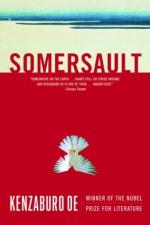|
This section contains 6,093 words (approx. 21 pages at 300 words per page) |

|
SOURCE: Yoshida, Sanroku. “The Burning Tree: The Spatialized World of Kenzaburō Ōe.” World Literature Today 69, no. 1 (winter 1995): 10-16.
In the following essay, Yoshida traces Ōe's literary development and asserts that the author's major thematic concerns “are closely related to his own personal problems and emotions, but he successfully distills them into a more universal context to produce a significant literary representation that is firmly grounded in human existence.”
Late on the night of 13 October 1994, in front of his residence in a usually quiet Tokyo suburb, Kenzaburō Ōe entertained questions from a horde of newspaper and television reporters who had gathered there to interview the winner of the 1994 Nobel Prize in Literature. “I wonder what kind of life I would be leading now,” he reminisced, “if I had not met professor Kazuo Watanabe at Tokyo University and learned from him about Rabelais forty years ago.” Born in 1935 in a...
|
This section contains 6,093 words (approx. 21 pages at 300 words per page) |

|


